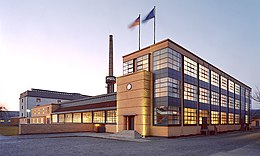
The Staatliches Bauhaus, commonly known as the Bauhaus, was a German art school operational from 1919 to 1933 that combined crafts and the fine arts. The school became famous for its approach to design, which attempted to unify individual artistic vision with the principles of mass production and emphasis on function.

Walter Adolph Georg Gropius was a German-American architect and founder of the Bauhaus School, who, along with Alvar Aalto, Ludwig Mies van der Rohe, Le Corbusier and Frank Lloyd Wright, is widely regarded as one of the pioneering masters of modernist architecture. He is a founder of Bauhaus in Weimar (1919). Gropius was also a leading architect of the International Style.

Jugendstil was an artistic movement, particularly in the decorative arts, that was influential primarily in Germany and elsewhere in Europe to a lesser extent from about 1895 until about 1910. It was the German counterpart of Art Nouveau. The members of the movement were reacting against the historicism and neo-classicism of the official art and architecture academies. It took its name from the art journal Jugend, founded by the German artist Georg Hirth. It was especially active in the graphic arts and interior decoration.

The International Style or internationalism is a major architectural style that was developed in the 1920s and 1930s and was closely related to modernism and modernist architecture. It was first defined by Museum of Modern Art curators Henry-Russell Hitchcock and Philip Johnson in 1932, based on works of architecture from the 1920s. The terms rationalist architecture and modern movement are often used interchangeably with International Style, although the former is mostly used in the English-speaking world to specifically refer to the Italian rationalism, or even the International Style that developed in Europe as a whole.

Modern architecture, or modernist architecture, was an architectural movement or architectural style based upon new and innovative technologies of construction, particularly the use of glass, steel, and reinforced concrete; the idea that form should follow function (functionalism); an embrace of minimalism; and a rejection of ornament. It emerged in the first half of the 20th century and became dominant after World War II until the 1980s, when it was gradually replaced as the principal style for institutional and corporate buildings by postmodern architecture. According to Le Corbusier the roots of the movement were to be found in the works of Eugène Viollet le duc.

The Deutscher Werkbund is a German association of artists, architects, designers and industrialists established in 1907. The Werkbund became an important element in the development of modern architecture and industrial design, particularly in the later creation of the Bauhaus school of design. Its initial purpose was to establish a partnership of product manufacturers with design professionals to improve the competitiveness of German companies in global markets. The Werkbund was less an artistic movement than a state-sponsored effort to integrate traditional crafts and industrial mass production techniques, to put Germany on a competitive footing with England and the United States. Its motto Vom Sofakissen zum Städtebau indicates its range of interest.
The year 1911 in architecture involved some significant architectural events and new buildings.
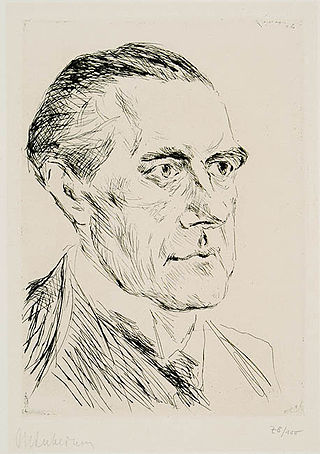
Peter Behrens was a leading German architect, graphic and industrial designer, best known for his early pioneering AEG Turbine Hall in Berlin in 1909. He had a long career, designing objects, typefaces, and important buildings in a range of styles from the 1900s to the 1930s. He was a foundation member of the German Werkbund in 1907, when he also began designing for AEG, pioneered corporate design, graphic design, producing typefaces, objects, and buildings for the company. In the next few years, he became a successful architect, a leader of the rationalist / classical German Reform Movement of the 1910s. After WW1 he turned to Brick Expressionism, designing the remarkable Hoechst Administration Building outside Frankfurt, and from the mid-1920s increasingly to New Objectivity. He was also an educator, heading the architecture school at Academy of Fine Arts Vienna from 1922 to 1936. As a well known architect he produced design across Germany, in other European countries, Russia and England. Several of the leading names of European modernism worked for him when they were starting out in the 1910s, including Ludwig Mies van der Rohe, Le Corbusier and Walter Gropius.

The first Werkbund Exhibition of 1914 was held at Rheinpark in Cologne, Germany. Bruno Taut's best-known building, the prismatic dome of the Glass Pavilion of which only black and white images survive today, was in reality a brightly colored landmark. Walter Gropius and Adolf Meyer designed a model factory for the exhibition. The Belgian architect Henri van de Velde designed a model theatre. Berlin-based Margarete Knuppelholz-Roeser designed the controversial Haus Der Frau.

Expressionist architecture was an architectural movement in Europe during the first decades of the 20th century in parallel with the expressionist visual and performing arts that especially developed and dominated in Germany. Brick Expressionism is a special variant of this movement in western and northern Germany, as well as in the Netherlands.

The Weissenhof Estate is a housing estate built for the 1927 Deutscher Werkbund exhibition in Stuttgart, Germany. It was an international showcase of modern architecture's aspiration to provide cheap, simple, efficient, and good-quality housing.
Der Ring was an architectural collective founded in 1926 in Berlin. It emerged from expressionist architecture with a functionalist agenda. Der Ring was a group of young architects, formed with the objective of promoting Modernist architecture. It took a position against the prevailing architecture of the time, Historicism. With the rise of National Socialism and the increasing difficulty between Hugo Häring and the other members, Der Ring dissolved in 1933.
In the meantime the German architects whose work follows newly discovered laws of design, have founded a new association. 'The Ring' — a figure of self-contained form without a head — unites a group of like-minded people to pursue their ideals in unison.

Yenidze is a former cigarette factory building in Dresden, Saxony, Germany built between 1907 and 1909. Today it is used as an office building. It is notable for its Moorish Revival exterior design which borrows design elements from mosques and the Alhambra in Spain.

The architecture of Germany has a long, rich and diverse history. Every major European style from Roman to Postmodern is represented, including renowned examples of Carolingian, Romanesque, Gothic, Renaissance, Baroque, Classical, Modern and International Style architecture.
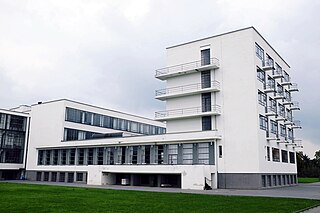
The New Objectivity is a name often given to the Modern architecture that emerged in Europe, primarily German-speaking Europe, in the 1920s and 30s. It is also frequently called Neues Bauen. The New Objectivity remodeled many German cities in this period.
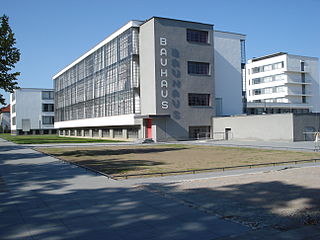
Bauhaus Dessau, also Bauhaus-Building Dessau, is a building-complex in Dessau-Roßlau. It is considered the pinnacle of pre-war modern design in Europe and originated out of the dissolution of the Weimar School and the move by local politicians to reconcile the city's industrial character with its cultural past.

The AEG turbine factory was built in 1909, at Huttenstraße 12–16 in the Moabit district of Berlin. It is the best-known work of architect Peter Behrens. The 100m long steel framed building with 15m tall glass windows on either side is considered the first attempt to introduce restrained modern design to industrial architecture. It was a bold move, and world first that would have a durable impact on architecture as a whole.

The Walter Gropius House is a residential building with nine floors and 66 apartments at the Händelallee 1-9 in Berlin Hansaviertel, bordering its central Grosser Tiergarten park. It was designed by Walter Gropius / The Architects' Collaborative - TAC in collaboration with Wils Ebert, Berlin, on the occasion of the first International Building Exhibition ( "Interbau"), in 1957. It is regarded as an important modernist landmark and was declared listed monument in 1980. The actress Marlene Dietrich was instrumental in funding the Interbau project.
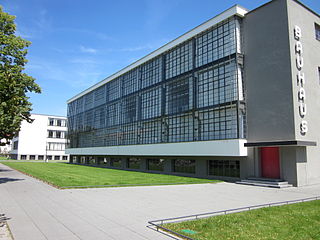
Bauhaus and its Sites in Weimar, Dessau and Bernau is a World Heritage Site in Germany, comprising six separate sites which are associated with the Bauhaus art school. It was designated in 1996 with four initial sites, and in 2017 two further sites were added.

Carl Fieger (1893–1960) was a German architect, designer, and teacher at the Bauhaus.
